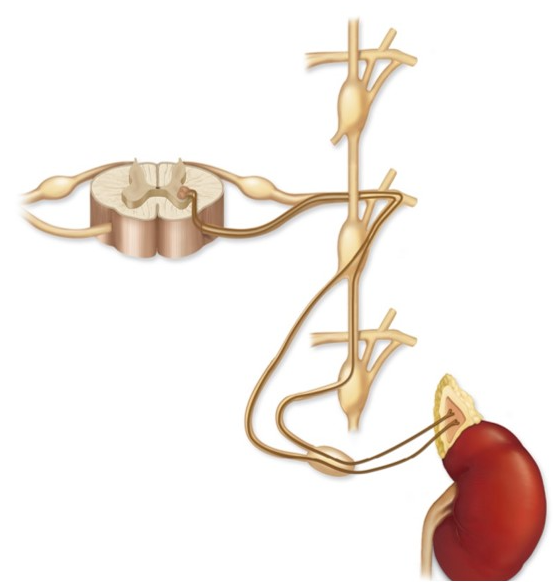Ch. 15 Autonomic Nervous System Quiz
1/30
There's no tags or description
Looks like no tags are added yet.
Name | Mastery | Learn | Test | Matching | Spaced |
|---|
No study sessions yet.
31 Terms
We lack awareness of many of our bodies' systems for maintaining homeostasis. The sensations, movements, and secretions of organs such as the heart and intestines are governed by the
autonomic nervous system.
Which is false regarding the somatic nervous system (SNS)?
The SNS is activated by visceral sensory neurons.
Which is not characteristic of the parasympathetic division of the ANS?
Long postganglionic axons
Which type of innervation causes the heart rate to increase?
Sympathetic
Which is not an effector innervated by the autonomic nervous system?
Skeletal muscle
The sympathetic and parasympathetic systems have_________ effects on heart rate.
antagonistic
Which division functions to increase alertness and direct bodily responses in stressful situations?
Sympathetic
Nicotinic receptors bind
acetylcholine and allow sodium ions to enter the cell.
The "fight-or-flight" system is the_________ nervous system.
sympathetic
Norepinephrine is a catecholamine.
true
Which statements are correct concerning the parasympathetic division of the ANS?
a: Contains preganglionic cell bodies in brainstem nuclei
b: Contains preganglionic cell bodies in the lateral horns of the T1–L2 regions
c: Participates in the “fight-or-flight” response
d: Helps maintain homeostasis
e: Contains preganglionic cell bodies in the sacral region of the spinal cord
a, d, e
Which of the following is correct about the autonomic nervous system (ANS)?
ANS functions are involuntary.
ANS motor pathways always include two neurons.
ANS motor neurons innervate cardiac muscle fibers, smooth muscle fibers, and glands.
The ANS is part of both the CNS and the PNS.
All of the choices are correct.
Which division functions to conserve energy and replenish the supply of nutrients?
Parasympathetic
The parasympathetic division of the ANS is also called the craniosacral division.
true
In an autonomic motor pathway, the first cell in the two-neuron chain is the _________ neuron.
preganglionic
Consider a basketball player whose heart is racing during the final moments of a game. With seconds on the clock, she makes a jump shot. Her excitement is a function of her_________ nervous system, and her movements are a function of her_________ nervous system.
sympathetic; somatic
The circuitry of the autonomic system allows for control in activation. The characteristic that allows a small number of preganglionic cells to stimulate a large number of postganglionic cells is
divergence
Once inside the sympathetic trunk, the sympathetic preganglionic axons
follow any of the routes listed.
When neurotransmitter binds to muscarinic receptors on smooth muscle cells in the gastrointestinal tract,
motility increases.
Preganglionic axons of the ANS release
acetylcholine
Autonomic tone refers to
the continual activity maintained by the sympathetic and parasympathetic divisions.
The sympathetic division of the ANS has
long postganglionic axons.
preganglionic neuron cell bodies in the T1–L2 regions of the spinal cord.
norepinephrine as neurotransmitter.
All of the choices are correct.
Which system has long preganglionic axons and therefore ganglia that are relatively far from the central nervous system?
parasympathetic nervous system

Which type of pathway is illustrated?
Adrenal medulla pathway
When ACh binds to nicotinic receptors, it
always produces an excitatory response.
Which system contains short preganglionic axons that branch extensively?
Sympathetic nervous system
Which type of innervation causes pupil dilation?
Sympathetic
When norepinephrine is released from postganglionic neurons, its targets are
adrenergic receptors on effectors such as smooth muscle.
Motor neurons of the autonomic nervous system
can either excite or inhibit effector organs.
The sympathetic division of the ANS is also called the thoracosacral division.
false
Dual innervation means that an individual effector
receives input from both the sympathetic and the parasympathetic nervous systems.